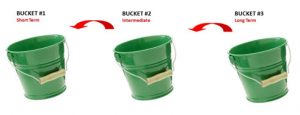Using a Bucket Strategy for Retirement Income Planning

There are several strategies that can be used to generate retirement income. One of those is the bucket theory of investing, which basically requires investors to contribute to three different buckets. There are variations to this bucket strategy of investing, so we encourage investors to find the right three-bucket approach for their specific needs. Read on to learn more about one approach…
Bucket One: In bucket one, investors should set aside enough cash to cover at a minimum one year’s worth of retirement expenses. This amount of cash should be invested in very conservative, highly liquid investments, such as an interest-bearing bank account, a money market fund, or short-term certificates of deposit. As necessary, the amount invested in bucket one could be less any other regular income received from pensions, Social Security, annuities, etc. Or, as an extra cushion, the amount invested in bucket one could be for the full years’ worth of retirement expenses. Future cash needs for bucket one will be replenished from the funds invested in ‘bucket two and/or bucket three’ of your investment portfolio.
Bucket Two: Bucket two serves the purpose of a short-term reserve with recommendations ranging from two to five years’ worth of living expenses, as possible. Having this short-term reserve helps you to withstand a prolonged market downturn, preventing the need to sell assets at reduced market prices. This short-term reserve should be invested in high quality, short term fixed income investments, and/or high-quality dividend-paying stocks. A portion of bucket two can also be invested into a bond ladder, with varying short-term maturity dates, and as these investments mature, the proceeds can be reinvested into bucket one.
Bucket Three: Bucket three represents the main portion of your investment portfolio and will consist of more aggressive investments. However, this bucket must be allocated with the proper mix of investments, so a well-diversified portfolio is maintained commensurate with your level of risk tolerance and long-term goals. This portion of your portfolio needs to be invested across multiple assets classes so it can cover periods beyond those of buckets one and two, while also becoming the source for replenishing buckets one and/or two on an as needed basis.
The three-bucket approach offers investors a simple, yet effective way to oversee their portfolios, save for retirement and manage their retirement income. Investment Account Manager’s software investing tool offers the ability to manage multiple portfolios, that can be designed around a bucket strategy approach that best suits an investors’ needs. Important to note, this retirement income plan, or any other investing strategy is only as good as the investments selected. Investors should be sure to rebalance their buckets at any time to reflect changes in income requirements or risk tolerance.